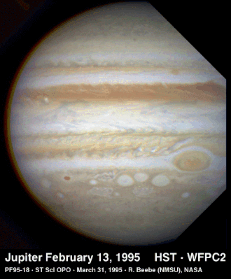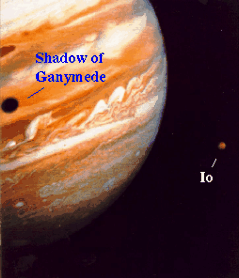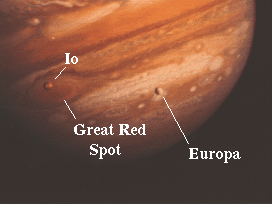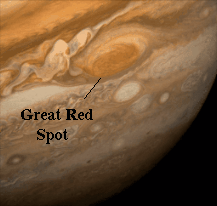 |
 |
| Storms in the atmosphere of Jupiter (Ref and Explanation) | Jupiter and Io with Ganymede's shadow on Jupiter (Ref) |
The Atmosphere of
Jupiter
[Note: Some excellent new pictures of Jupiter appear here, many made possible by the Cassini mission on its present path to Saturn as it passed by Jupiter!] Check out these which show Jupiter with its moon Io in front: cool pic 1 and cool pic 2
The outermost layer is composed primarily of ordinary molecular hydrogen and helium which is liquid in the interior and gaseous further out. The atmosphere we see is just the very top of this deep layer. Water, carbon dioxide, methane and other simple molecules are also present in tiny amounts.
Three distinct layers of clouds are believed to exist consisting of ammonia ice, ammonium hydrosulfide and a mixture of ice and water. However, results from the Galileo probe show only faint indications of clouds (one instrument seems to have detected the topmost layer while another may have seen the second). But the probe's entry point (left) was unusual -- Earth-based telescopic observations and more recent observations by the Galileo orbiter suggest that the probe entry site may well have been one of the warmest and least cloudy areas on Jupiter at that time.
Data from the Galileo atmospheric probe also indicate that there is much less water than expected. The expectation was that Jupiter's atmosphere would contain about twice the amount of oxygen (combined with the abundant hydrogen to make water) as the Sun. But it now appears that the actual concentration much less than the Sun's. Also surprising was the high temperature and density of the uppermost parts of the atmosphere.
Jupiter has a very complex atmosphere. It is dominated by colorful bands and turbulent swirls, as illustrated in the following two images.
 |
 |
| Storms in the atmosphere of Jupiter (Ref and Explanation) | Jupiter and Io with Ganymede's shadow on Jupiter (Ref) |
Each hemisphere has around 6 bands with winds blowing at very high velocities in opposite directions. This accounts for the extensive shear and turbulence at the boundaries between these regions (see the next section on the Great Red Spot). Large lightning bolts and extensive aurora have been observed in the Jovian atmosphere, as we will discuss further when we consider Jupiter's magnetic field.
 |
 |
| Jupiter with two moons seen against its surface | Jupiter's clouds near the Great Red Spot |
In 1992, SL 9 passed by Jupiter within the Roche limit. It was broken into at least 21 separate fragments which were dispersed several million kilometers along its orbit.
Here are some pictures fragment G impact. Note that the fireball is obsevered 12 minutes after impact. top 20 images of the impacts of fragments.
The estimates of size and mass of the original body and the individual fragments range from 2 to 10 km in diameter for the original body and from 1 to 3 km for the largest fragments.
Between 16 July 1994 and 22 July 1994 the fragments impacted the upper atmosphere of Jupiter. This was the first time that scientists had an opportunity to witness the collision of two extraterrestrial bodies. The impacts were observed by virtually every large ground based telescope, thousands of small and amateur telescopes, and several spacecraft including HST and Galileo. The pictures were posted to the Net within hours of the impacts and caused severe overloading on some ftp and WWW sites. The after-effects of the impacts were visible on Jupiter for nearly a year after the event.
Each fragment hit with about 60km/sec velocity and released energy equivalent 3 million of megatons of TNT. This would be equivalent to 30 million Hiroshima bombs(!) or 30 times the total available nuclear weaponry on Earth.